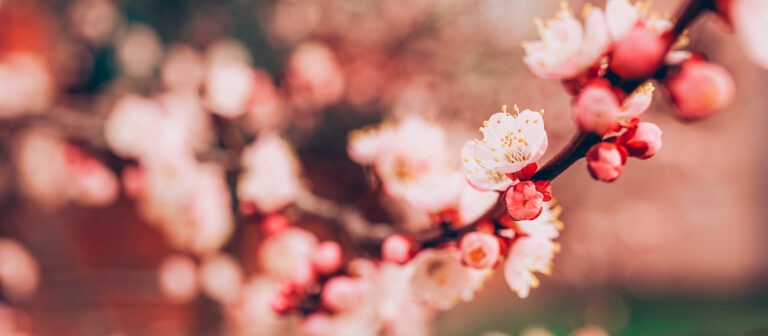
清明 Qīng Мíng: Clear and Bright
April 4th through April 18th marks the time of 清明 Qīng Míng, which translates as Clear and Bright.
April 19th through May 4th marks the time of谷雨 Gu Yu, or Grain Rain, the 6th term in the Ancient Chinese solar calendar. It is also the last solar term of the spring season. 谷雨 Gu Yu begins when the Sun reaches the celestial longitude of 30° and ends when it reaches the longitude of 45°.
Grain Rain Legend
仓颉 Cāngjié, a legendary figure of ancient China who lived approximately 4,000 years ago was the official historian of 黃帝 Huangdi, the Yellow Emperor, and the creator of Chinese characters. Legend has it that when 仓颉 Cāngjié created the first Chinese character, angelic deities exclaimed in adoration and rained millet onto people from the heavens.
“Rain brings up the growth of hundreds of grains.”
– Ancient Chinese Proverb
The 3 pentads of 谷雨 Gu Yu are:
1st pentad – 獺祭魚 duckweed begins to sprout
2nd pentad – 鴻雁來 cuckoo shakes off wings.
3rd pentad – 草木萌動 hoopoe perches in mulberry trees.
Grain Rain marks the end of snow and frost in the Northern Hemisphere. Outside temperatures begin rising rapidly in Northern China and rain falls in abundance. It is a peak time for planting corn and rice. Crops grow fast and strong during this solar term. While farmers are busy protecting their crops from pests during 谷雨 Gu Yu, people in China exercise prevention and boost their immune systems.
Harvesting and cooking 香椿 Xiāng Chūn, commonly known as Chinese mahogany and Chinese cedar, is a famous tradition in Northern China during Grain Rain. It is a joyous affair in which friends and family come together.
“Toona Sinensis before the rain is as tender as silk.”
-Ancient Chinese Proverb
The 谷雨 Gu Yu, or Grain Rain solar term is also significant to fishing communities in the coastal areas of Northern China. Fishermen celebrate the arrival of Grain Rain at a 2,000 year old 谷雨 Gu Yu Festival. It marks the first time in the annual cycle when fishermen can safely return to sea and resume their fishing voyages.
谷雨 Gu Yu is the time of year when the flower of Guyu or peony (牡丹 mǔ dān) comes into full bloom, attracting spectators from far and wide. Peony is the “king of flowers” in China. Its design was often sewn into imperial clothes, it adorned imperial gardens, and it continues to be widely represented in art projects. Chinese people believe that this unique flower can enrich a person’s life as many times as each blossom has petals. Since time immemorial this flower has been a symbol of wealth and prosperity in Chinese culture.
“Moss covered paths between scarlet peonies Pale jade mountains fill your rustic windows I envy you, drunk with flowers Butterflies swirling in your dreams.”
-Chinese poet 钱起Qian Qi, 唐朝Tang Dynasty (618 – 907)
“Springtime radiance, gradually, gradually where does it go Again before a wine jar, we take up a goblet All day we’ve questioned the flowers, but the flowers do not speak For whom do they shed their petals and leaves, for whom do they bloom
-Peonies at Jixing Temple by隋煬帝 Emperor Yang of the 隋朝 Sui Dynasty (581-618)
Peony fairs are traditional popular events which attract countless spectators who come to appreciate the splendor of the blooming gorgeous peony flowers. Beauty and elegance are not the only characteristics this flower is famous for. The peony plant has valuable medicinal properties and has been used in Traditional Chinese Medicine for thousands of years. Read more about the Legend of Peony and Chinese Physician Hua Tuo here.
Some acupoints to consider using during this time are 合谷 Large Intestine 4 Hé Gǔ, and 太衝 Liver 3 Tài Chōng as well as 支溝 San Jiao 6 Zhī Gōu. During the period of 春分 Chūn Fēn we want to be mindful of the process of equilibrium. The four gates is a perfect acupoint combination to create balance in the body. San Jiao 6 allows the smooth flow of Qi. In conjunction with the acupoints mentioned, utilize either the Free and Easy Wanderer Decoction (Xiao Yao Tang) or make sure that the blood flow to the four extremities are in equilibrium by utilizing the principles of Dang Gui Si Ni Tang.
The principle of balance should be considered paramount at this time as the balance of the planet begins to move towards summer warmth and increased Qi and Blood circulation.
Also consider using formulas like:
逍遙湯 Xiao Yao Tang
當歸四逆湯(集) Dang Gui Si Ni Tang
In the realm of Chinese Food Therapy consider adding papaya and blackberries to your patient population’s regime.
If you have any further questions, you can setup a 15 minute Q&A session with me here when you sign up for a Si Jin Bao PRO account.

Founder & Chief Herbaceutical Engineer

April 4th through April 18th marks the time of 清明 Qīng Míng, which translates as Clear and Bright.

春分 Chūn Fēn, translated as Spring Equinox, is the 4th solar term in the Ancient Chinese solar calendar. This year it starts on March 20th and continues through April 3rd.






Ancient Wisdom Fused with Modern Technology